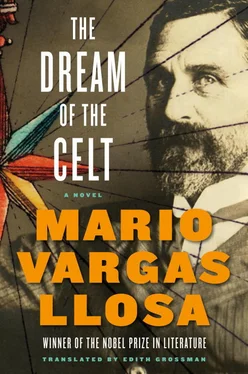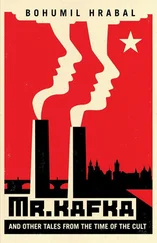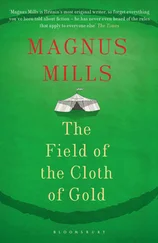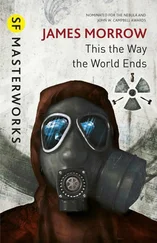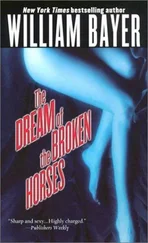When, in February 1885, at the Berlin Conference that not a single Congolese attended, the fourteen participating powers, headed by Great Britain, the United States, France, and Germany, graciously ceded to Leopold II—at whose side Henry Morton Stanley was a constant presence—the million square miles of the Congo and its twenty million inhabitants so that he “would open the territory to commerce, abolish slavery, and civilize and Christianize the pagans,” Roger, who had just turned twenty-one and had lived for a year in Africa, celebrated the event. So did all the employees of the International Congo Society who, anticipating this concession, had already spent time in the territory, establishing the foundations of the project the monarch was ready to carry out. Roger was strong, very tall, slim, with intensely black hair and beard, deep gray eyes, and little propensity for jokes, a laconic boy who seemed a mature man. His preoccupations disconcerted his associates. Who among them took seriously the story about the “civilizing mission of Europe in Africa” that obsessed the young Irishman? But they appreciated him because he was hardworking and always prepared to lend a hand and take over a shift or an assignment for anyone who asked. Except for smoking, he seemed free of vices. He drank almost no alcohol and when, in the camps, tongues were loosened by drink and the talk turned to women, he was clearly uncomfortable and wanted to leave. He was a tireless explorer of the jungle and an imprudent swimmer in rivers and lagoons, energetically moving his arms in front of somnolent hippopotamuses. He had a passion for dogs, and his companions recalled the day during the expedition of 1884 when a wild boar buried its tusks in his fox terrier, named Spindler, and he suffered an emotional crisis when he saw the small animal bleeding to death, its flank torn open. Unlike the other Europeans on the expedition, money did not matter to him. He had not come to Africa dreaming of becoming rich but was moved instead by incomprehensible ideas such as bringing progress to the savages. He spent his salary of eighty pounds sterling a year on his associates. He lived frugally. He did, however, care for his person, dressing carefully, washing himself and combing his hair at mealtimes as if instead of camping in a clearing or on a river beach he were in London, Liverpool, or Dublin. He had a facility for languages, had learned French and Portuguese, and managed to speak several words of their African dialect after spending a few days near a tribe. He was always making notes in student copybooks of what he saw. Someone found out he wrote poetry. They made a joke about it and embarrassment barely permitted him to stammer a denial. He once confessed that when he was a boy, his father would beat him with a strap, and for that reason he was angered by the overseers when they whipped the natives if they dropped a load or failed to carry out an order. He had the gaze of a dreamer.
When Roger thought of Stanley he was hampered by contradictory feelings. He continued to recuperate slowly from malaria. The Welsh adventurer had seen in Africa only a pretext for dramatic exploits and personal plunder. But how could he deny he was one of those mythical, legendary beings who, by means of daring, scorn for death, and ambition, seem to have shattered the limits of the human? He had seen him carry in his arms children whose faces and bodies were eaten by smallpox, offer water from his own canteen to natives dying of cholera or sleeping sickness, as if no one could infect him. Who had this champion of the British Empire and the ambitions of Leopold II actually been? Roger was certain the mystery would never be revealed and his life would always remain hidden behind a spider’s web of inventions. What was his real name? He had taken the name of Henry Morton Stanley from a New Orleans merchant who, in the dark years of his youth, was generous to him and perhaps adopted him. It was said his real name was John Rowlands, but he never confirmed that to anyone. Or that he had been born in Wales and spent his childhood in one of those orphanages where children who had been picked up on the street by health officials were sent. Apparently, when he was very young, he left for the United States as a stowaway on a freighter, and there, during the Civil War, fought first in the Confederate ranks as a soldier, and then on the Yankee side. Afterward, it was thought, he had become a reporter and written articles about the advance of the pioneers into the west and their battles with the Indians. When the New York Herald sent him to Africa in search of David Livingstone, Stanley had no experience at all as an explorer. How did he survive the trek through virgin forests, like someone searching for a needle in a haystack, and succeed in finding in Ujiji, on November 10, 1871, the man he stupefied, according to his boastful confession, with his greeting: “Dr. Livingstone, I presume?”
Of all Stanley’s accomplishments, the one Roger Casement had admired most in his youth, even more than his expedition from the sources of the Congo River to its outlet into the Atlantic, was the construction of the caravan trail between 1879 and 1881. The caravan route opened a way for European commerce from the mouth of the great river to the pool, an enormous fluvial lagoon that, as years passed, would be named for the explorer: the Stanley Pool. Afterward, Roger discovered this was another of the farsighted operations of the king of the Belgians to create the infrastructure that would permit the territory to be exploited following the Berlin Conference of 1885. Stanley was the audacious executor of that design.
“And I,” Roger would often tell his friend Herbert Ward during his African years, as he was becoming aware of what the Congo Free State meant, “was one of his foot soldiers from the beginning.” Though not exactly, since when he reached Africa, Stanley had already spent five years opening the caravan trail, whose first section, from Vivi to Isanguila, fifty miles up the Congo River, was completed at the beginning of 1880 and consisted of tangled, fever-ridden jungle filled with deep ravines, worm-infested trees, and putrid swamps where the tops of the trees blocked the sunlight. From there to Muyanga, some seventy-five turbulent miles, the Congo was navigable for pilots familiar with those waters, able to avoid whirlpools and, when it rained and the water rose, to take shelter in shallows or caves and not be tossed against the rocks and destroyed in the rapids that appeared and disappeared endlessly. When Roger began to work for the AIC, changed after 1885 into the Congo Free State, Stanley had already founded, between Kinshasa and Ndolo, the station he called Leopoldville. It was December 1881, three years before Roger reached the jungle and four before the Congo Free State would be legally born. By then this colonial possession, the largest in Africa, created by a monarch who would never set foot in it, was a commercial reality to which European businessmen had access from the Atlantic, overcoming the obstacle of a Lower Congo made impassable by rapids, cataracts, and the twists and bends of the Livingstone Falls, thanks to the route Stanley opened over almost three hundred miles between Boma and Vivi to Leopoldville and the pool. When Roger came to Africa, bold merchants, the advance guard of Leopold II, were beginning to go deep into Congolese territory and take out the first ivory, skins, and baskets of rubber from a region filled with trees that oozed black latex, within reach of anyone who wanted to harvest it.
During his early years in Africa, Roger traveled the caravan route upriver several times, from Boma and Vivi to Leopoldville, or downriver, from Leopoldville to the river’s mouth at the Atlantic, where the dense green waters became salty and where, in 1482, the caravel of the Portuguese Diego Cão entered Congolese territory for the first time. Roger came to know the Lower Congo better than any other European residing in Boma or Matadi, the two points from which Belgian colonization advanced toward the interior of the continent.
Читать дальше
